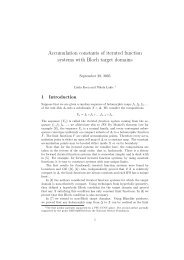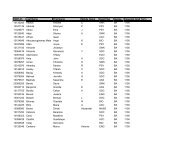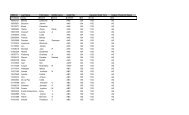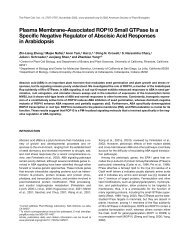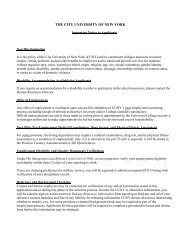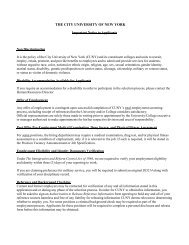Statistical physics
Statistical physics
Statistical physics
You also want an ePaper? Increase the reach of your titles
YUMPU automatically turns print PDFs into web optimized ePapers that Google loves.
⟩∣∣ ∣∣temperature, excited levels of the system become populated and the average spin value decreases, ∣⟨Ŝi < S. At hightemperatures all energy levels become populated, so that neighboring spins can have all possible orientations withrespect to each other. In this case, if there is no external magnetic field acting on the spins (see Sec. XIII), the averagespin value should be exactly zero, because there as many spins pointing in one direction as there are the spins pointingin the other direction. This is why the high-temperature state is called symmetric state. If now the temperature islowered, there should be a phase transition temperature T C (the Curie temperature for ferromagnets) below whichthe order parameter (average spin value) becomes nonzero. Below T C the symmetry of the state is spontaneouslybroken. This state is called ordered state. Note that if there is an applied magnetic field, it will break the symmetry bycreating ⟩∣a nonzero spin average at all temperatures, so that there is no sharp phase transition, only a gradual increase∣ ∣∣of ∣⟨Ŝi as the temperature is lowered.Although ⟩∣ the scenario outlined above looks persuasive, there are subtle effects that may preclude ordering and∣ ∣∣ensure ∣⟨Ŝi = 0 at all nonzero temperatures. As said above, ordering does not occur in one dimension (spin chains)for both Ising and Heisenberg models. In two dimensions, Ising model shows a phase transition, and the analyticalsolution of the problem exists and was found by Lars Osager. However, two-dimensional Heisenberg model does notorder. In three dimensions, both Ising and Heisenberg models show a phase transition and no analytical solution isavailable.24A. The mean-field approximation for ferromagnetsWhile a rigorous solution of the problem of phase transition is very difficult, there is a simple approximate solutionthat captures the <strong>physics</strong> of phase transitions as described above and provides qualitatively correct results in mostcases, including three-dimensional systems. The idea of this approximate solution is to reduce the original many-spinproblem to an effective self-consistent one-spin problem by considering one spin ⟩(say i) and replacing other spins in theinteraction by their average thermodynamic values, −J ij Ŝ i · Ŝ j ⇒ −J ij Ŝ i ·⟨Ŝj . One can see that now the interactionterm has mathematically the same form as the term describing interaction of a spin with the applied magnetic field,Eq. (153). Thus one can use the formalism of Sec. (XIII) to solve the problem analytically. This aproach is calledmean field approximation (MFA) or molecular field approximation and it was first suggested by Weiss for ferromagnets.The effective one-spin Hamiltonian within the MFA is similar to Eq: (153) and has the form(⟩)Ĥ = −Ŝ· gµ B B + Jz⟨Ŝ + 1 ⟨Ŝ⟩ 22 Jz , (181)where z is the number of nearest neigbors for a spin in the lattice (z = 6 for the simple cubic lattice). Here the last⟩⟩⟨Ŝ⟩ 2term ensures that the replacement Ŝ ⇒⟨Ŝ in⟨ŜĤ yields Ĥ = − ·gµ B B − (1/2)Jz that becomes the correct∣ ∣∣ground-state energy at T = 0 where ∣⟨Ŝ⟩∣= S. For the Heisenberg model, in the presence of a whatever weak appliedfield B the ordering will occur in the direction of B. Choosing the z axis in this direction, one can simplify Eq. (181)to(⟩)Ĥ = − gµ B B + Jz⟨Ŝz Ŝz + 1 ⟩ 2 ⟨Ŝz2 Jz . (182)The same mean-field Hamilotonian is valid for the Ising model as well, if the magnetic field is applied along the zaxis. Thus, within the MFA (but not in general!) Ising and Heisenberg models are equivalent. The energy levelscorresponding to Eq. (182) are(⟩)ε m = − gµ B B + Jz⟨Ŝz m + 1 ⟩ 2 ⟨Ŝz2 Jz , m = −S, −S + 1, . . . , S − 1, S. (183)Now, after calculation of the partition function Z, Eq. (155), one arrives at the free energy per spinF = −k B T ln Z = 1 2 Jz ⟨Ŝz⟩ 2− kB T lnsinh [(S + 1/2)y], (184)sinh (y/2)wherey ≡⟩gµ B B + Jz⟨Ŝz. (185)k B T



